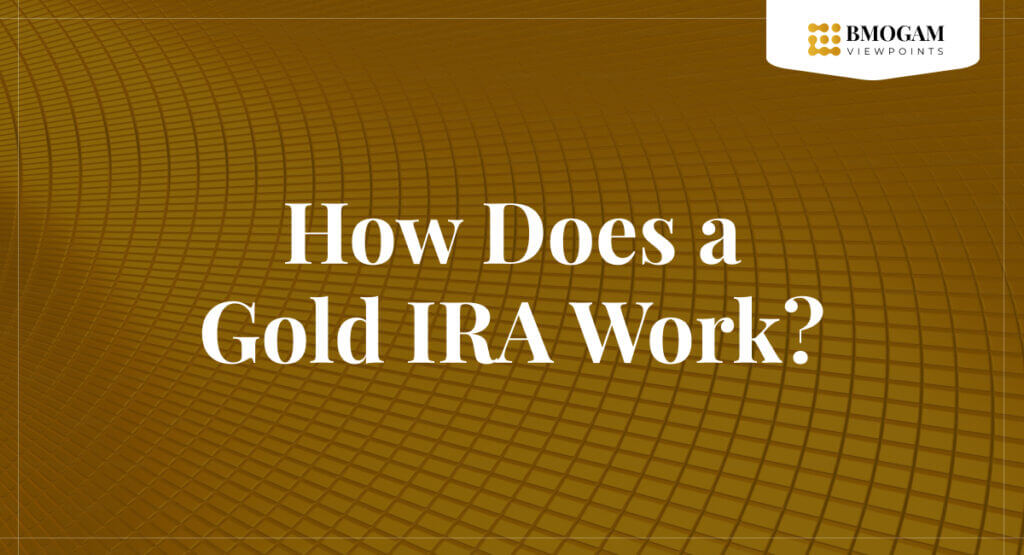Disclaimer: We are reader supported. We may be compensated from the links in this post, if you use products or services based on our expert recommendations. Please read our Advertising Disclosure.
Many investors are asking how to buy physical gold in an IRA?
Well, back in the day, gold was an integral part of the economy as it served both as a way to make everyday purchases and also to store wealth.
Today, it is considered a "collectible" - like rare coins, stamps, or antiques.
The IRS doesn't allow investors to put collectibles into an IRA. However, there is an exception to this rule which allows gold to be held in an IRA through a special gold IRA account.
Keep reading and we'll tell you what you need to know about buying physical gold inside a tax-protected IRA.
Before we get started:
We understand how difficult it is to pick a company that you can trust with your hard earned savings. That's why we create informative and useful information to give you as much knowledge as possible to make the right decision.

We created a list of our highest recommended investment companies, to make comparing and choosing the company best suited to your needs as easy as possible.
Or...
Get a FREE Gold Investing Kit from our #1 recommendation, by clicking the button below:
Learn How to Protect Your Wealth Today!
Understanding a Physical Gold IRA
A gold IRA (also known as a Precious Metals IRA) is an Individual Retirement Account that holds physical gold instead of traditional investments like stocks and bonds.
A gold IRA allows investors to take advantage of the potential appreciation value of physical gold while still enjoying the tax benefits associated with a traditional retirement account.
Reasons Why Investors Buy Gold in an IRA
Gold IRAs appeal to investors because they provide an edge over inflation. Gold prices generally tend to move independently of stocks, bonds, and other paper assets. This feature helps to smooth out risks, especially when markets are volatile.
Gold allows investors to diversify their portfolios. Putting all your money in one type of asset is risky, but having a portion of your portfolio in physical gold can help to mitigate risk.
Because gold prices often rise when other investments are falling, buying physical gold in an IRA can lead to greater long-term returns and stability.
Additionally, the costs associated with setting up and maintaining a gold IRA are typically lower than those for a traditional account.
The fees for storage and insurance may be slightly higher due to the nature of gold as an asset class, but these expenses may be offset by the potential appreciation value of the metals over time.
Last but not least, investors can choose from a variety of different types of gold when they set up their gold IRA. These include coins, rounds, bars, wafers, and even gold jewelry.
This makes it easy to find a product that meets one's individual investment needs and goals.
Process for Investing in a Gold IRA
To invest in physical gold through a gold IRA, an investor will need to open a self-directed IRA account with an authorized custodian.
The custodian will act as the trustee for their account, helping them purchase approved investments, store them securely, and facilitate distributions when needed.
Investors will then fund their gold IRA account with cash or transfers from existing retirement accounts. They will select their preferred precious metal investments and arrange for the metals to be stored in a secure depository.
Finding a Broker or a Custodian
As mentioned, an investor must have an authorized custodian to purchase and store physical gold in an IRA. This person or entity will help create and administer the gold IRA account, so care must be taken when choosing one.
First, it's important to choose a custodian that is reliable and trustworthy. Given the substantial amount of money involved, investors should only work with custodians with a good reputation and solid track record.
Secondly, investors should look for a custodian with low fees. Fees can vary significantly from one company to the next, so it pays to compare different options and shop around for the best deal.
Investors should also ask about additional services offered by the custodian, such as asset tracking and storage.
Thirdly, flexibility in a custodian may be a very useful trait when investing in gold IRA. There are situations where investors may need to modify their investment strategy, and having the ability to do so quickly and easily is an important factor to consider.
Last but not least, an investor must deal with a custodian will all the appropriate and required licenses, registrations, certifications, and insurance.
Doing business with a custodian that is fully compliant with all local and federal regulations will help ensure your investments are secure and in good hands.
Finding and Working with a Gold Broker
Of course, an investor will have to get their gold from somewhere, and this is where a broker comes in. A broker can assist with sourcing the best gold products available at competitive prices.
They will also be able to help investors decide what type of gold investments are right for their needs and advise on any changes that may need to be made in the future.
When looking for a broker, investors should ask about qualifications, experience, fees, customer service, and other important criteria. The Better Business Bureau (BBB) provides helpful information about brokers so that investors can make informed decisions about who they choose to do business with.
It's also wise to talk to friends or family members who have purchased precious metals from brokers to get reliable referrals.
We know it's hard to find a precious metals dealer you can trust and depend on for creating and maintaining a physical gold IRA, that is why we researched the entire precious metals industry and create our list of the few, but best companies to work with.
You can read our list of the Best Gold IRA Companies here.
Tax Implications
Gold IRA accounts aren't subject to the same taxes as traditional retirement accounts, but they do come with some special considerations. Any profits made from transactions within a gold IRA will not incur capital gains tax.
However, when withdrawals are taken after the age of 59 1/2, there may be tax liabilities depending on whether or not contributions were made on a pre-tax or post-tax basis.
A pre-tax basis means that the funds used to purchase gold weren't previously subject to taxation. For example, if the investor used money from their 401(k) to finance their gold IRA, the withdrawals would be fully taxable.
On the other hand, post-tax contributions mean any withdrawal made is tax-free since taxes were already paid on the funds initially.
Special Costs
Owning gold in a gold IRA comes with its own cost, such as custodian fees for setting up and managing the account. They may also charge additional fees for storage, insurance, and even shipping or handling if physical gold is purchased.
Moreover, investors can incur cash-out costs. These come about when they want to close out a gold IRA by selling their gold and taking out the cash.
Depending on the custodian, they may charge extra fees for closing out an account or cashing in gold investments.
Withdrawing From a Gold IRA
The IRS treats a gold IRA just like all the other retirement accounts. Therefore, it is available either as a traditional or Roth IRA.
If an investor has a traditional gold IRA with contributions made from pre-tax money, the withdrawals will be taxed just as ordinary income.
Distributions received before the age of 59 1/2 will face a 10% penalty, and after reaching the age of 72, the investor will have to start taking required minimum distributions (RMDs).
For Roth Gold IRA, withdrawals are tax-free. However, investors need to wait for five years after their first contribution before taking out any money. This applies even if they reach the age of 59 1/2 or older.
Checkbook IRA
If an investor wants to avoid the hassle and costs of dealing with a custodian and storage avenues, they can open a checkbook IRA, which is a self-directed IRA custodian.
This way, investors have direct control over their investments and can make all the decisions themselves.
To do this, the investor must own a limited liability company (LLC) and open an IRA account with a bank or mutual fund. Then they transfer the funds from their 401(k) or traditional IRA into their LLC, which is then used to buy gold or other investments.
A checkbook IRA isn't for everyone, though. For it to work, investors must have a certain level of experience and understanding of investments to make the right decisions.
It can also be difficult to manage all the paperwork, as well as keep track of taxes and fees. And lastly, there are additional costs associated with hiring accountants and other professionals for advice when needed.
Rollover Gold IRA
If an investor already has an IRA or 401(k) with precious metals, they can use these for their gold IRA. This process is called a rollover, and it allows an investor to move money into the gold IRA from other retirement accounts without incurring any tax penalties.
As straightforward as it may seem, there are some factors to consider when rolling over funds into a gold IRA. For example, investors may be giving up gains that could have been earned if the investments had stayed in the earlier account.
This can be hard to predict and depends on market conditions at the time of the rollover. Additionally, rolled gold may not include all coins or bars that are allowed in a gold IRA.
Gold IRA's Risks and Considerations
Gold prices can be volatile, but are usually less volatile than paper assets, and the market is often unpredictable, but they have a track record of going up in the long run.
Therefore, a gold IRA would be suitable for an investor willing to be patient and endure some market fluctuations for months or even years. Additionally, when physical gold is bought or stored, there are storage costs that have to be taken into account.
Moreover, there may be additional taxes for transferring funds out of a retirement account into a gold IRA or vice versa.
A gold IRA also requires investors to find an approved custodian and storage facility, as well as ensure all paperwork is in order before any transactions can happen.
This means spending time on research so that investors make the right decision for their portfolios and financial situation. Lastly, if an investor is considering investing in physical gold, they may also be susceptible to the risk of theft.
Someone could just break into their depository and steal their gold assets. So, the IRA requires every depository to be insured before they can store any investor's gold assets.
An investor must be sure to confirm this because some custodians may offer inadequate coverage.
Conclusion
Overall, gold IRAs are an option for investors looking to diversify their retirement portfolio with the addition of physical gold.
Although there are risks and challenges involved, the potential rewards may outweigh them in the long run.
As always, investors should do research and seek professional advice before making any decisions about investing in a gold IRA.
Doing so will ensure they make informed choices that best suit their financial objectives and goals.
You can get a Free Gold Investors Guide from our top gold and precious metals company recommendation by clicking the link above or you can read our article of the top companies we reviewed this year:
>> CLICK HERE to read our list of the Top Gold Investing Companies. <<

I started BMOGAM Viewpoints as a way to compile all my views on investing in one place. I own my home, have some real estate, and own a few stocks like most people, but what really drives my interest in investing is I have a strong love of precious metals, especially gold.



